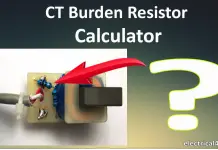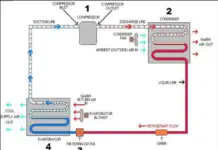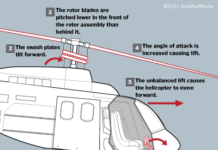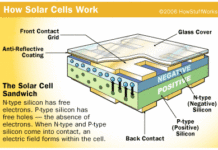Basic Of Engine Cooling System:
A car engine is basically an internal combustion engine where power is generated through expansion of high temperature and high pressure gasses. A lot of heat is generated due to combustion gas and the friction of mechanical parts. For sustained operation these excess heat should be removed from the engine and kept at operating temperature. In this article, we are going to see how engine cooling system works,
Cooling system parts
- Water pump
- Radiator
- Thermostat
- Coolant temperature sensor (CTS)
- Coolant ( antifreeze + water )
Water pump In Engine Cooling System:
The water pump is the heart of cooling system which pumps coolant. It consists of an impeller, a pulley, flange and O-Ring the impeller is driven by the engine drive belt through a pulley.
Radiator In Engine Cooling System:
The radiator is a heat exchanges used to transfer the excess heat developed by engine to the atmosphere. The radiator is having an inlet port, outlet port, drain plug and a radiator pressure cap. The radiator pressure cap plays a vital role in the cooling system.
Thermostat
The thermostat is a valve which regulates the flow of the coolant and helps to maintain the proper operating temperature for the engine.
The thermostat consists of a frame change cylinder, main valve, main spring, and bypass valve, coolant and temperature sensor (CTS).
Coolant and temperature sensor in Engine Cooling System
The coolant temperature sensor is used to monitor the engine temperature. The coolant will use this data to manage fuel injection and ignition time. Some engines have more than one coolant temperature sensor. The data is also used to control the radiator fan and update the temperature gauge on the driver console.
The coolant temperature sensor consists of a sensing probe and electrical connector. Most coolant temperature sensor as negative temperature coefficient type which means temperature increases the resistance will decreases. The CTS can be a two pin type or a three pin type depending upon the make of the vehicle.
Working
The piston contained inside the engine block in which each of them will function. Above the engine block comes the head of gasket which provides sealing between engine block and engine head. It avoids compression leaks and oil or coolant leaks into the cylinder above that comes the engine head.
The engine is having a safe passage through which the coolant flows without entering into the cylinder or mixing up with the oil. This damage is known as water jacket.
The water pump pumps the coolant throughout the system with the help pf the radial impeller. It is driven by the engine itself using a serpentine belt. The serpentine belt also drives the power steering pump, alternator, AC compressor, but now only water pump is used.
The thermostat bye pass hose, thermostat housing inside thermostat, the radiator and radiator fan lower radiator hose, water pump outlet hose, upper radiator hose, the coolant expansion tank, expansion bleed hose, coolant over flow hose,
The thermostat is actually a valve which regulates the flow of the coolant. It will always cover in coolant so that the temperature can be sensed.
Let us see the operation of cold engine.
When the engine is cold the bypass valve stays open, so the coolant by passes the radiator and recirculates through the engine. This helps the engine the coolant temperature quickly. Eventually the coolant temperature increases by absorbing the heat from the engine.
Once the coolant starts to reach higher temperature which is usually between 160 degree to 190 degree Fahrenheit the bypass valve will start to close and the main valve will start to open.

This allows the cold coolant from radiator flow to the engine side and hot coolant from engine side to the radiator. In most cars the coolant temperature sensor is located near the thermostat housing.
It will turn on the radiator fan if the coolant to the radiator side is at high temperature. Now the hot coolant in the radiator will release its heat to the atmosphere with the help of fan. At the same time the cold coolant received from the radiator will start to absorb the heat from the engine for the next cycle.

Heating liquid inside a closed system always build up pressure so how to maintain the pressure. Here comes the role of the radiator pressure cap. It consists of a spring loaded valve mechanism which will respond to higher pressure.
Reading a pressure above 15 psi will push the pressure cap valve and the coolant flows to the expansion tank until the pressure goes down to operation level and when the system cools down the vacuum inside the system sucks the expansion tank.
In case if there too much pressure build up in the system due to trapped air or other failures the coolant in the expansion tank will be pushed out through the overflow hose.

Heater system
The car heater system is a part of the engine cooling system. The heater system comprises the heater core, inlet and outlet hose and heater control valve which is optional and cannot be found in all vehicles. The heater core acts as a radiator dissipation heat from the hot coolant to the vehicle interior using a blower.
Image/Content Credit: https://www.youtube.com/channel/UCqZQJ4600a9wIfMPbYc60OQ















